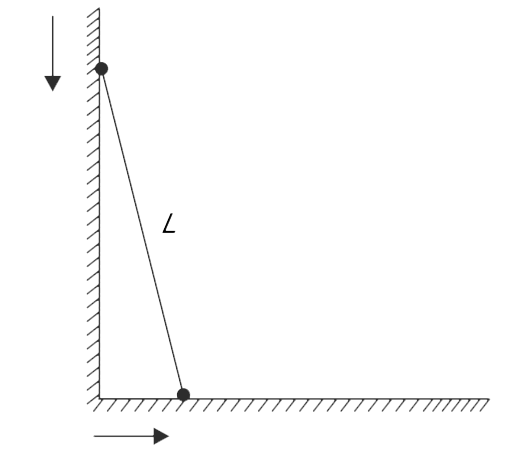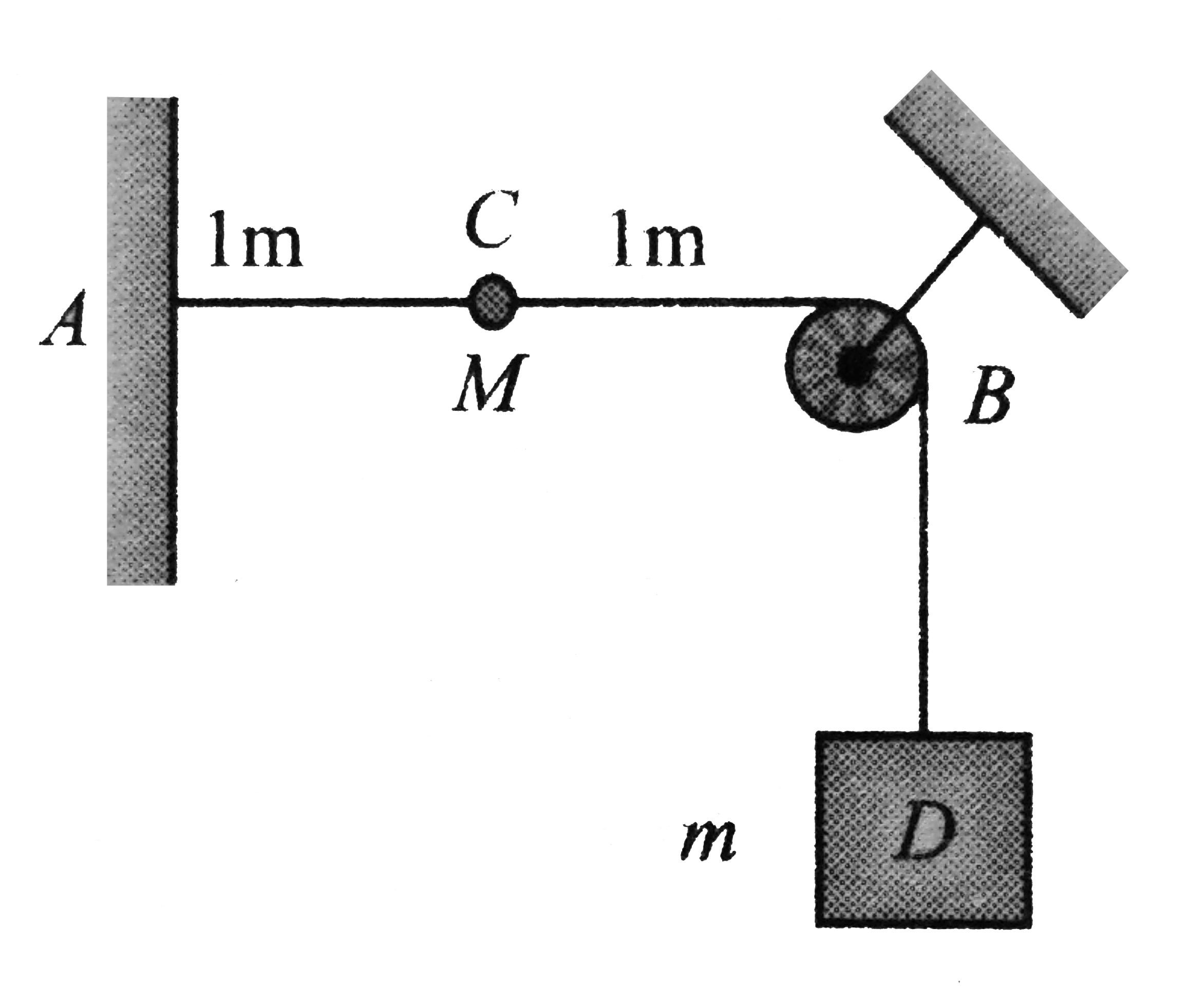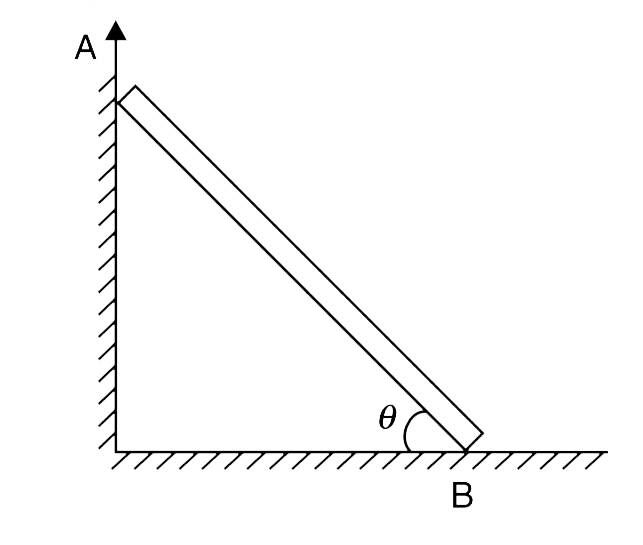A dumb – bell has a rigid mass less stick and two point masses at its ends. Each mass is m and length of the stick is L. The dumb- bell leans against a frictionless wall, standing on a frictionless ground. It is initially held motionless, with its bottom end an infinitesimal distance from the wall. It is released from this position and its bottom end slides away from the wall where as the top end slides down along the wall.
(a) Show that centre of mass of the dumb-bell moves along a circle.
(b) When the dumb-bell loses contact with the wall what is speed of the centre of mass?

The correct Answer is:(b)
Topper's Solved these Questions
Similar Questions
Let →u be the initial velocity of a particle and →F be the resultant force acting on it . Describe the path that the particle can take if
(a) →u×→F=0and→F=constant
(b) →u.→F=0and→F=constant
In which case can the particle retrace its path .
View SolutionTwo particles of mass m1 and m2 are connected by a spring of natural length L and force constant k. The masses are brought close enough so as to compress the spring completely and a string is used to tie the system. Assume that length of spring in this position is close to zero. The system is projected with a velocity V0 along the positive x direction. At the instant it reaches origin at time t = 0, the string snaps and the spring starts opening.
(a) Show that the mass m1(orm2) will are perform SHM in the reference frame attached to the centre of mass of the system. Find the time period of oscillation.
(b) Write the amplitude of m1 and m2 as a function of time. lt( c) Write the X co ordinates of m1 and m2 as a function of time

View SolutionA string with one end fixed on a rigid wall, passing over a fixed frictionless pulley at a distance of 2m from the wall, has a point mass M of 2kg attached to it at a distance of 1m from the wall. A mass m of 0.5kg is attached to the free end. The system is initially held at rest so that the stirng is horizontal between wall and pulley and vertical beyond the pulley as shown in figure.

What will be the speed with which point mass M will hit the wall when the system is released? (g=10ms−2)
View SolutionA string with one end fixed on a rigid wall, passing over a fixed frictionless pulley at a distance of 2 m from the wall, has a point mass M of 2 kg attached to it at a distance of 1 m from the wall. A mass in of 0.5 kg is attached to the free end. The system is initially held at rest so that the string is horizontal between wall and pulley and vertical beyond the pulley as shown in Fig. The system is released from the rest from the position as shown. The ratio of velocity of M and m when M strikes the wall is
View SolutionA massless stick of length L is hinged at one end and a mass m attached to its other end. The stick is free to rotate in vertical plane about a fixed horizontal axis passing through frictionless hinge. The stick is held in a horizontal position. At what distance x from the hinge should a second mass M = m be attached to the stick, so that stick falls as fast as possible when released from rest
View SolutionA ladder rests against a frictionless vertical wall, with its upper end 6m above the ground and the lower end 4m away from the wall. The weight of the ladder is 500N and its CG at 1/3rd distance from the lower end. Wall's reaction will be (in newton)
View SolutionA stick of length L=2.0m is leaned against a wall as shown. It is released from a position when θ=60∘. The end A of the stick remains in contact with the wall and its other end B remains in contact with the floor as the stick slides down. Find the distance travelled by the centre of the stick by the time it hits the floor.

View SolutionA chain of mass M and length L is held vertical by fixing its upper end to a rigid support. The tension in the chain at a distance y from the rigid support is:
View Solutionएक 5cm लम्बी सीढ़ी दीवार के सहारे झुकी है। सीढ़ी का निचे का सिरा ,जमीन के अनुदिश दीवार से दूर 2cm /s की दर से खींचा जाता है।दीवार पर इसकी ऊंचाई किस दर से घट रही है। जबकि सीढ़ी के निचे का सिरा दीवार से 4cm दूर है।
View Solution20 किग्रा द्रव्यमान की एक 3 मी. लंबी सीढ़ी एक घर्षण विहीन दीवार के साथ झुकाकर टिकाई गई है जैसा कि चित्र में दर्शाया गया है । इसका निचला सिरा फर्श पर दीवार से 1 मी. की दूरी पर है । दीवार और फर्श के प्रतिक्रिया बल ज्ञात कीजिए ।
View SolutionA ladder 3 meters long is leaned against the wall. The bottom end of the ladder is drawn away from the BARE ground at a rate of 1.5 m per second. Find the rate at which the angle between the ladder and the ground is changing when the bottom end of the ladder is 12 m 0 x away from the wall?
View SolutionA chain of mass M and length L is held vertical by fixing its upper end to a rigid support. The tension in the chain at a distance y from the rigid support is:
View SolutionA uniform ladder which is 5m long has a mass of 25kg , leans with its upper end against a smooth vertical wall and its lower end on rough ground. The bottom of the ladder is 3m from the wall. Calculate the frictional force between the ladder and the ground . (g=10ms^(-2) )
View SolutionA string with one end fixed on a rigid wall, passing over a fixed frictionless pulley at a distance of 2m from the wall, has a point mass M of 2kg attached to it at a distance of 1m from the wall. A mass m of 0.5kg is attached to the free end. The system is initially held at rest so that the stirng is horizontal between wall and pulley and vertical beyond the pulley as shown in figure. What will be the speed with which point mass M will hit the wall when the system is released? (g=10ms^-2)
View SolutionA chain of mass M and length L is held vertical by fixing its upper end to a rigid support. The tension in the chain at a distance y from the rigid support is:
View Solution
